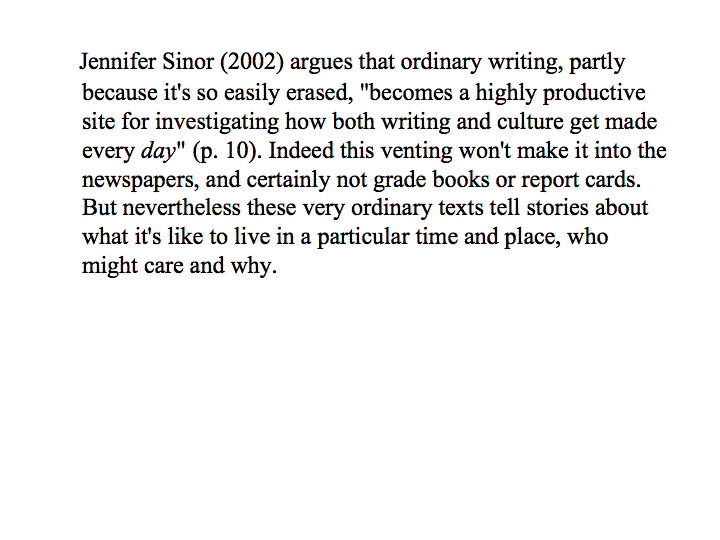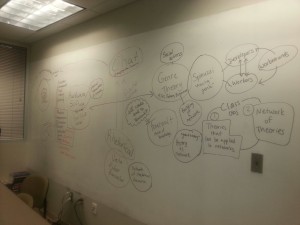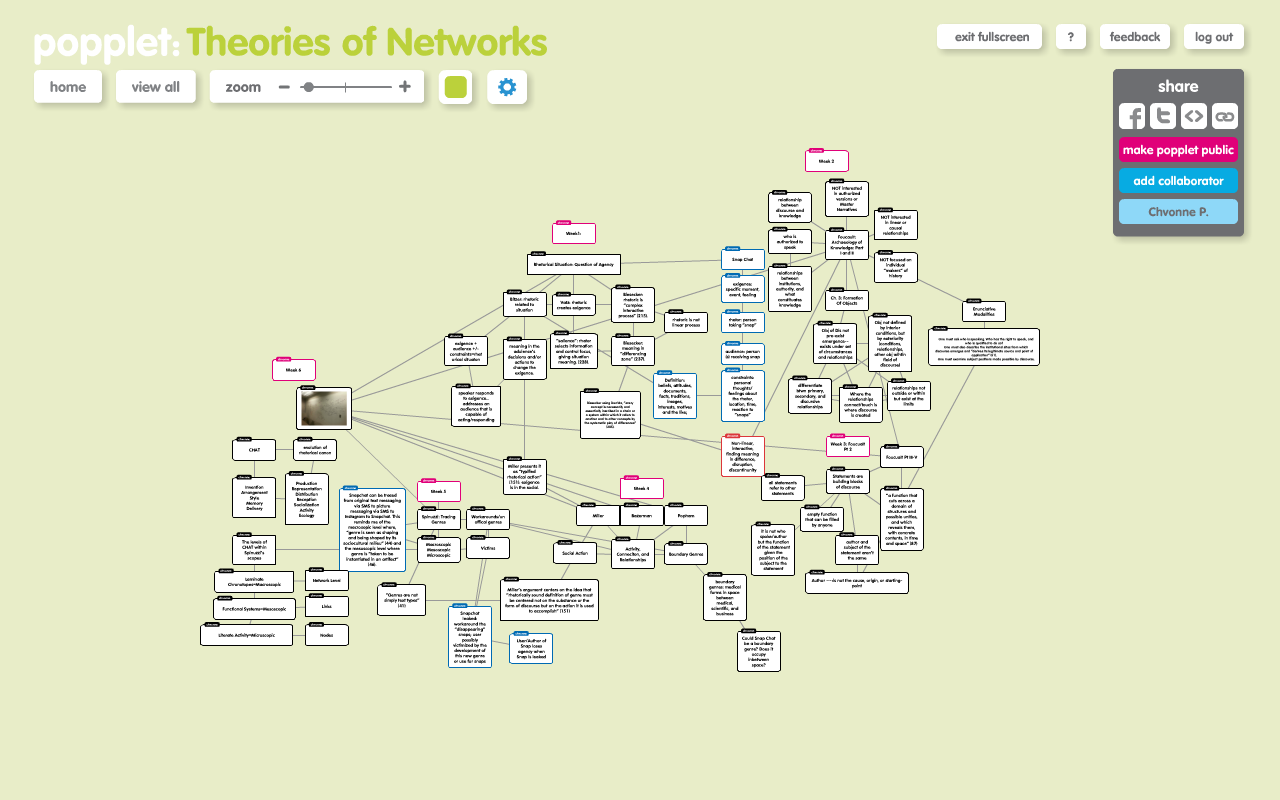What is Chat?
The discussion of cultural-historical activity theory (CHAT) led me into a crazy game of connect the dots. I am not sure what the final image will be, but I am making connections.
CHAT is a synthesis of concepts from a variety of different disciplines and sub-disciplines. The authors argue that “CHAT rejects the notion that human action is governed by some neo-platonic realm of rules, whether the linguistic rules of English, the communicative norms of some discourse community, or cognitive scripts for acting in a particular situation. It argues that activity is situated in concrete interactions that are simultaneously improvised locally and mediated by historically provided tools and practices” (Prior et al,. “What is Chat”).
This use of CHAT immediately brought to mind what we have read about genre theory. In regards to genre theory, CHAT seems to be the opposite of genre as social action. Miller argues that “rhetorically sound definition of genre must be centered not on the substance or the form of discourse but on the action it is used to accomplish” (151). CHAT on the other hand, as mentioned above, argues that “activity is situated in concrete interactions” (“What is Chat?”).
This is interesting because people are essentially networks. The connections and interactivity bring people together (into alignment with the system) and also individualized people (separate nodes):
“In activity, people are socialized (brought into alignment with others) as they appropriate cultural resources, but also individuated as their particular appropriations historically accumulate to form a particular individual. Socialization (learning) simultaneously makes people and societies because what is appropriated and individuated is also externalized in activity and, thus, alters the social.“
The Core Text
The core text focuses on “a new mapping of rhetorical activity, one that acknowledges and advances in our understanding of language, semiotics, human development, technology, and society.” The authors argue for advancing the traditional understanding of the rhetorical canon (invention, arrangement, style, memory, and delivery). Using CHAT the authors argue for looking at rhetorical canons as “complex set of interlocking systems within which a rhetors are formed, act, and navigate.” This argument is interesting as it further complicates the agency of the rhetor presented in the works of Bitzer, Vatz, and Biesecker. In CHAT the rhetor and the audience are socialized. They (and we) exist in a more complex world. I was intrigued by the idea that “prototypical scene of rhetoric…[is] essentially in monologue.” This was interesting to me because I have always thought of rhetoric as being social in that it s concerned with audience and audience action. When I think about it I see how it is stuck in a binary (speaker and hearer). Rhetorical activity is centered around the rhetor or the situation. Although Biesecker complicates this by pointing out the interactive nature of rhetor and audience, the focus is still primarilyon the speaker and the audience.
My two articles:
I was responsible for reading Mar P. Sheridan-Rabideau’s “Kairos and Community Building: Implications for Literacy Researchers” and Liz Rohan’s “Nobody told me that college was this hard!: ‘Venting’ in the grad stacks.” Both of these articles discuss community. Sheridan-Rabideau’s article focuses on the literacy practices of a community group as they try to put up a billboard. This exploration examined how this community group moved towards being institutionalized and professionalized. They primarily communicated to the community. The billboard required them to change their presentation because they were moving beyond their community group and moving into a permanent space.

Funny Bathroom Graffiti
Rohan’s article examines how students “venting” on the library study room vents “create an imagined community of readers and writers.” The venting is presented as a system instead of a text with with rhetor. Rohan argues that “the act of writing on those vents enacts production, reception, distribution, and representation all dependent on participant’s collective participation in a larger ecology.” This second article resonated with me for several reasons. The first reason is that the writing on the vents remind me of Snapchat. The writing on the vents is easily erased. The writings, just like snaps, are about everyday things, personal time (studying), and intimate moments. The ephemeral and personal nature of the vents reminds me of Snapchat. Rohan notes:


The idea that the audience and the artifacts have agency in that they socialize others complicates the relationship between author and audience. The vents have a permanence that snaps do not have. The vents can be remediated for new audience. Snaps cannot because they “disappear.” The vents, memory, ecology, and community are pushing me to rethink how I perceive the interactions on Snapchat. It is also causing me to rethink the impact of the “disappearance” on snaps. Memory operates in a different way with snaps. Snaps are to serve as a
way to document and share memories so that they last within the individual but not in a concrete or retrievable space. Moving forward, I am interested in how the expanded canon applies to modern communications versus the classical canon. I am especially interested in the addition of reception and memory in regards to Snapchat. I am not sure where I will go with these three areas, but I think that reception of snaps in regards to whether the person saves the snap. What impact does the disappearing aspect of Snapchat have on memory, if any?
Bibliography
Prior, Paul, et. al. “Re-situating and Re-mediating the Canons: A Cultural-Historical Remapping of Rhetorical Activity: A Collaborative Core Text. Kairos, 11.3 (Summer 2007). Web. 15 Feb. 2014.
Paul, Prior. “Remaking IO, Remaking Rhetoric: Semiotic Remediation as Situated Rhetorical Practice.” Re-situating and Re-mediating the Canons: A Cultural-Historical Remapping of Rhetorical Activity: A Collaborative Core Text. Kairos, 11.3 (Summer 2007). Web. 15 Feb. 2014.
Prior, Paul, et. al. “What is CHAT?” Re-situating and Re-mediating the Canons: A Cultural-Historical Remapping of Rhetorical Activity: A Collaborative Core Text. Kairos, 11.3 (Summer 2007). Web. 15 Feb. 2014.
Rohan, Liz. “Nobody told me that college was this hard!: “Venting” in the grad stacks”. Re-situating and Re-mediating the Canons: A Cultural-Historical Remapping of Rhetorical Activity. Kairos, 11.3 (Summer 2007). Web. 15 Feb. 2014.
Sheridan-Rabideau, Mary P. “Kairos and Community Building: Implications for Literacy Researchers.” Re-situating and Re-mediating the Canons: A Cultural-Historical Remapping of Rhetorical Activity. Kairos, 11.3 (Summer 2007). Web. 15 Feb. 2014.
Van Ittersum, Derek. “Data-Palace: Modem Memory Work in Digital Environments.” Re-situating and Re-mediating the Canons: A Cultural-Historical Remapping of Rhetorical Activity. Kairos, 11.3 (Summer 2007). Web. 15 Feb. 2014.
 For my digital MindMap, I added nodes for CHAT focusing specifically on the connections between the laminate chronotopes, functional systems, and literate activity and Spinuzzi’s macroscopic, mesoscopic, and microscopic. In my mind, both of these functioned from the abstract to the concrete. With the microscopic and literate activity levels acting as the nodes and the functional systems operating on the mesoscopic level as the links between the nodes. I also made parallel nodes for the classic rhetorical canon and the remapped canon, connecting the elements of the classical canon to the remapped canon. I did not develop all this information out in the popplet in order to save space. Also, I made a connection between CHAT and Foucault. If archaeology is the process for understanding or examining discursive trace of the past to understand and write the present history, the remapping of the rhetorical canon is a tracing of or looking at history in order to understand and transform what is being done in the present.
For my digital MindMap, I added nodes for CHAT focusing specifically on the connections between the laminate chronotopes, functional systems, and literate activity and Spinuzzi’s macroscopic, mesoscopic, and microscopic. In my mind, both of these functioned from the abstract to the concrete. With the microscopic and literate activity levels acting as the nodes and the functional systems operating on the mesoscopic level as the links between the nodes. I also made parallel nodes for the classic rhetorical canon and the remapped canon, connecting the elements of the classical canon to the remapped canon. I did not develop all this information out in the popplet in order to save space. Also, I made a connection between CHAT and Foucault. If archaeology is the process for understanding or examining discursive trace of the past to understand and write the present history, the remapping of the rhetorical canon is a tracing of or looking at history in order to understand and transform what is being done in the present.

